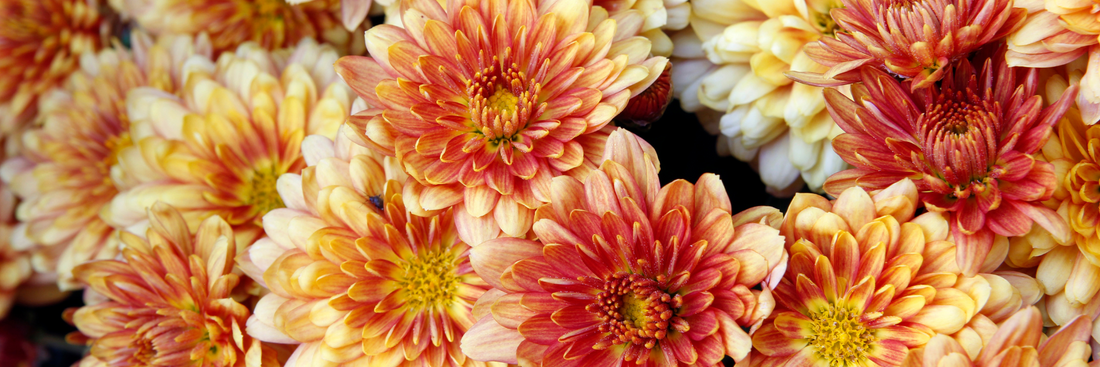Chrysanthemums are timeless beauties, and they have a rich history. They are popular throughout the world and their wide variety of colours inspire a range of uses and meanings. A Chinese philosopher is even believed to have said, ‘If you would be happy for a lifetime, grow chrysanthemums’.
Despite their long history and enduring popularity, chrysanthemums are often overlooked as a ‘focal’ flower. But not at The Flower Farm. We have been sowing, growing, picking and arranging chrysanthemums for over 40 years! And if you’re not already a fan, today we’re going to try to win you over. So we’re talking all things chrysanthemums, including their history, meaning and blooming appeal.
The Flower Farm guide to chrysanthemum flowers
History of chrysanthemum flowers
The history of chrysanthemums starts in China, where they were described as a flowering herb as early at the 15th century BC. In ancient China chrysanthemums had several uses:
-
Roots were boiled to make a headache remedy.
-
Petals and sprouts were eaten.
- Leaves were brewed for a festive tea.
Of course, as with all good things, news of chrysanthemums beauty and benefits travelled. And there are recordings of chrysanthemums in Japan from around the 8th century AD.
In Japan chrysanthemum flowers have endured as symbol of happiness and long life and are a popular autumn flower. Chrysanthemums are also the floral emblem of the imperial family in Japan, and appear on Japanese passports. In fact, they’re so popular that there are many chrysanthemum festivals in Japan.
Chrysanthemums travelled to the western world in the 17th century AD. Different species were then cultivated, and the blooms spread all across Europe.
Naming of ‘chrysanthemum’

Chrysanthemums are part of the Asteraceae (or daisy) family, one of the largest botanical families in the world. They were named in 1753 by Carl Linnaeus, a Swedish botanist. Linnaeus combined the Greek words ‘chrysos’ meaning ‘gold’ and ‘anthemon’ meaning ‘flowers’. So chrysanthemums really means ‘golden flowers’.
Chrysanthemums today

Chrysanthemums today grow in a wide array of varietals and colours. If asked to picture a chrysanthemum, most people think of what’s known as florist’s chrysanthemum (‘Chrysanthemum x grandiflorum’ or ‘Chrysanthemum morifolium’). They produce large, beautiful, pom-pom shaped flower heads on a long stem. The petals curve both upwards and inwards, to form a globe or sphere.
However, according to The National Chrysanthemum Society, there are 13 different classes of chrysanthemum flowers – from the multi-petalled pompoms described above to singe daisies.
Chrysanthemums also flower in all the colours of the rainbow from pastel to vibrant hues. And each of these different colours are associated with different meanings. Their foliage is also a beautiful, but subtle matte green – the perfect backdrop for their array of hues. And they’re a birth month flower for November babies.
The colours and meanings of chrysanthemum flowers

Chrysanthemums are a popular choice for Mothers’ Day in Australia. This could be because they are abundantly available around May, flowering from late summer through to autumn. It could also be because ‘mum’ is part of their name!
Chrysanthemums generally mean well-being, happiness and friendship. But their different colours have different meanings. Let’s look at which colour chrysanthemum will be your best choice of bloom:
- Red chrysanthemums are associated, like red roses, with passionate, romantic love.
- Pink chrysanthemums have connotations of femininity and grace.
- Orange chrysanthemums are said to mean happiness and excitement.
- Yellow chrysanthemums should only be sent to express sorrow and are also said to represent unrequited love.
- Green chrysanthemums are an excellent choice to express good fortune and good health.
- Blue chrysanthemums are rare but feature in literature (where they symbolise loyalty and devoted love) and art (where they symbolise grace, elegance and beauty).
- Violet chrysanthemums are hard to find, and are said to mean thoughtfulness and care.
- White chrysanthemums in Western Europe, China and Japan are the flower of mourning or grief. But in Australia, they mean loyalty, innocence and honesty.
Our suggestions: White Seasonal Bunch or Bright Seasonal Bunch
When is the best time to send chrysanthemums

As well as Mothers’ Day and November birthdays, at The Flower Farm, we think chrysanthemums are a wonderful ‘just because’ flower. Being mindful of their various colour meanings, chrysanthemum flowers make an abundant, beautiful bouquet or arrangement whatever the occasion.
Chrysanthemums are also a long-lasting cut flower, making them a thoughtful choice for sending your love, thoughts or well-wishes.
Our suggestions: Pink Seasonal Bunch or Pastel Seasonal Bunch
Caring for chrysanthemums
The beautiful chrysanthemum blooms will stay fresh (with care) in vases for up to 14 days. Trim leaves from stems, then cut each stem on an angle before placing them into a clean vase with fresh water.
The Flower Farm and chrysanthemum flowers
The Sihota family started The Flower Farm in the Redlands in 1978. In 1981, we planted our first crop of chrysanthemums. Along with our signature carnations, chrysanthemums remain our first floral love and a flower we have years of experience in sowing, growing, picking and arranging.
We have enjoyed sharing our love for often overlooked chrysanthemum flowers and hope you have too. Call in and see us at The Flower Farm shop in Birkdale or give us a call. We’d love to arrange a bespoke bunch of chrysanthemums for you or a loved one.


